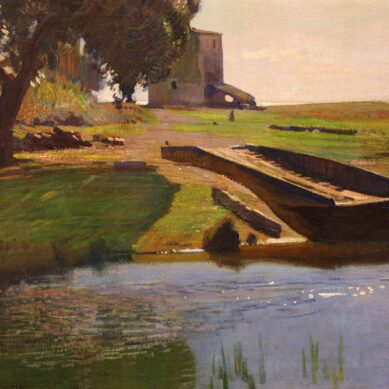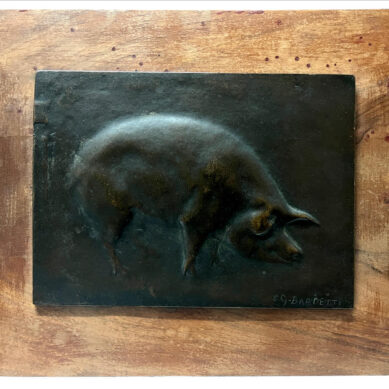You searched
Painter
Arturo Noci
Are you interested in the sales or the purchase of his artworks?
We buy works of this artist
and of other painters and sculptors from the 16th century to the first half of the 20th century
The Berardi gallery offers a free and without obligation service for evaluation of ancient and modern art . To find your way in the art market, very complex and full of nuances, it is better to rely on a professional consultant who can answer fast and concretely to your needs. The clarity of the answers will resolve effectively the need to estimate or sell an asset.
Contact us immediately without commitment
Answers also in 24 hours:
Arturo Noci
Arturo Noci
Arturo Noci, born on 23 April 1874 in Rome, capital of the Kingdom of Italy for just three years, takes his first steps in the world of art already in the quiet of the home. The parents, in fact, were both established artists. His father Ercole was a sculptor, painter and inlayer, specialized in painted glass. Together with his father Giuseppe, he had a studio in via Fontanella Borghese: a real ante litteram design laboratory, where furniture was produced for elegant aristocratic residences, highly appreciated even outside Italy.
Among the clients of the Noci studio we should mention Matilde Serao and Edoardo Scarfoglio, who, as told in 1885 by the young Gabriele d’Annunzio editor for “La Tribuna”, had entrusted Ercole and Giuseppe Noci with the realization of the furnishings for their wedding house in Rome, described in detail by the poet from Abruzzo. Her mother, Tecla Monacelli, was also a painter: “uncommon painter”, according to the poet and journalist Giacinto Stiavelli, “skilled, more than anything else, in copying old paintings, some of which would be exchanged, at first sight, with the same original, such is the wisdom with which they are conducted ».
It is therefore conceivable that it was the parents who encouraged the very young Arturo to undertake artistic studies in 1887 at the Royal Institute of Fine Arts in Rome, under the guidance of the painter Filippo Prosperi (Artena 1831 – 1913), who taught the course drawing. Already in the academic field Noci had his first acknowledgments, being several times winner of internal competitions, both in the figure, in the perspective and in the ornamentation: these are years of absolute dedication to study, in which he tirelessly draws on his notebooks pieces of nature and numerous portraits and paints the most diverse subjects, often on small formats, even experimenting with ceramic painting according to the family tradition (a small oval plate with a scene of grazing cows dated 1888 is known. Rome, private collection).
Thanks to the excellent reputation he earned at the Institute of Fine Arts, Noci soon reached other important goals: in 1895 he was appointed full member of the International Artistic Association of Rome, while in 1896 he was awarded the Stanzani Prize for painting organized by the Academy dei Virtuosi del Pantheon and in 1897, in addition to the medal of encouragement for the “landscape prize” of the Werstappen legacy of the Academy of San Luca, he obtained a four-year pension at the Pio Istituto Catel.
The works of this period reveal an already defined, personal and recognizable artistic language, although filtered by the influence of the most interesting international artists active in the late nineteenth century. The first reference, for Noci as for other Roman painters of his own generation, is Antonio Mancini, “this great artist who exerts a fascination on young talents who give themselves to painting” 8.
Providing one of the sharpest evidence of the interest shown by young people in Mancini’s painting in the early nineties of the nineteenth century is his colleague Camillo Innocenti, one of the painters closest to Noci’s artistic feeling, who recalls in his autobiography: ” as soon as we began to see Mancini’s paintings we young people even lost our heads. I was joined by the scoldings in the house of my father and my older brother who reproached me for running after a madman. I swallowed, but I didn’t change my mind.
I went to see him in a study outside Porta del Popolo […] the suggestion of his painting was so strong that all of us young people had become imitators without, of course, ever getting even a little closer to the power and vivacity of his art. But we copied it in styling a model, in choosing a color ». In the same way, the painter Fausto Vagnetti, in an article dedicated to his Roman colleague Umberto Coromaldi – another artist very close to Noci both in an artistic and human sense – recalls: “we were around 1890 when Antonio Mancini began to gain the reputation of a powerful master of contemporary painting, in exchange for the hunger that asinity and misoneism had made him suffer, and the very young Roman artists had gathered around him to begin the eternal struggle of the new against the old ».
From Mancini, Noci first of all assimilated the predilection for pure colors and the potential of warm tone accords, often applied with dense brushstrokes. Although left-handed echoes can be seen throughout Noci’s Roman period, it is in his figure paintings made between the late nineteenth and early twentieth centuries that the master’s lesson becomes more evident: see, for example, the Prodigal Son of 1898 (Rome, Pontifical Distinguished Academy of Fine Arts and Letters of the Virtuosi at the Pantheon) and Un fervente del 1900, presented at the exhibition of the Society of Amateurs and Cultors that same year in the hall of the group “In Arte Libertas”; or the Bacchant of 1901, whose expression seems to recall that of the protagonists of the left-handed portraits, characterized, as Ugo Ojetti wrote, by “that somewhat fixed and strained laugh of the acrobat who then jumped off the trapeze”.
Parallel to landscapes, scenes of Vannutellian reminiscence such as Villa Borghese and interiors studied from life, as shown by the numerous sketches on notebooks, Noci created some paintings of Old Testament subjects in the context of retirees, in which the lesson of Morelli history or sacred painting for any young artist active between Rome and Naples in the second half of the nineteenth century) was cloaked in symbolist echoes: see, for example, Repudiation of Hagar and Judith and Holofernes.
The comparison with international painting is evident in this production, with particular reference to England and the Pre-Raphaelites. The knowledge of the works of painters such as Rossetti, Burne Jones and Waterhouse, in addition to their diffusion in numerous specialized magazines of the time, is due to the influence exerted on the young Roman painters by Giulio Artistide Sartorio, who had shown to adhere to the aestheticizing vague between the mid-eighties and nineties of the nineteenth century in the wake of the poetic suggestions of Gabriele D’Annunzio.
Noci’s debt to D’Annunzio’s aestheticism filtered by Sartorio’s brush is strong in works such as Woman picking flowers, a final essay for the pensioner of the Pio Istituto Catel. In any case, the artist here seems to refer to an iconography brought to commercial success by Waterhouse, author of numerous paintings depicting women intent on picking flowers, and even earlier by Lawrence Alma Tadema, in works such as Flora or Spring in the gardens of Villa Borghese (private collection).













